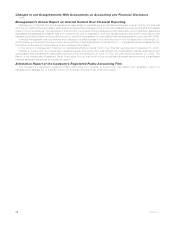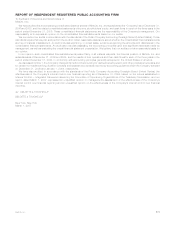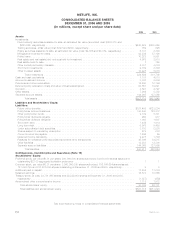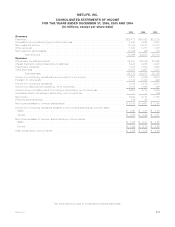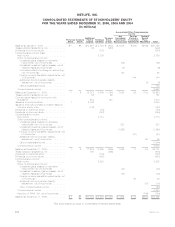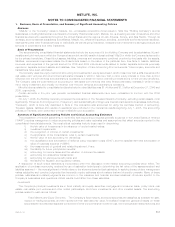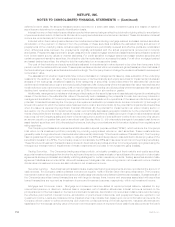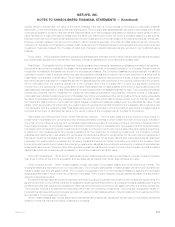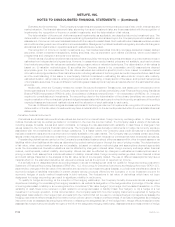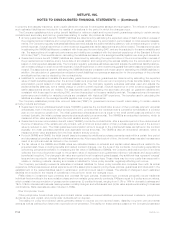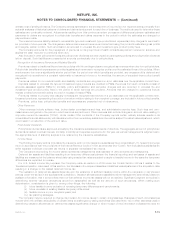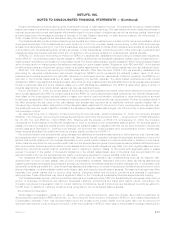MetLife 2006 Annual Report Download - page 90
Download and view the complete annual report
Please find page 90 of the 2006 MetLife annual report below. You can navigate through the pages in the report by either clicking on the pages listed below, or by using the keyword search tool below to find specific information within the annual report.METLIFE, INC.
NOTES TO CONSOLIDATED FINANCIAL STATEMENTS
1. Business, Basis of Presentation, and Summary of Significant Accounting Policies
Business
“MetLife” or the “Company” refers to MetLife, Inc., a Delaware corporation incorporated in 1999 (the “Holding Company”), and its
subsidiaries, including Metropolitan Life Insurance Company (“Metropolitan Life”). MetLife, Inc. is a leading provider of insurance and other
financial services with operations throughout the United States and the regions of Latin America, Europe, and Asia Pacific. Through its
domestic and international subsidiaries and affiliates, MetLife, Inc. offers life insurance, annuities, automobile and homeowners insurance,
retail banking and other financial services to individuals, as well as group insurance, reinsurance and retirement & savings products and
services to corporations and other institutions.
Basis of Presentation
The accompanying consolidated financial statements include the accounts of (i) the Holding Company and its subsidiaries; (ii) part-
nerships and joint ventures in which the Company has control; and (iii) variable interest entities (“VIEs”) for which the Company is deemed to
be the primary beneficiary. Closed block assets, liabilities, revenues and expenses are combined on a line-by-line basis with the assets,
liabilities, revenues and expenses outside the closed block based on the nature of the particular item. See Note 9. Assets, liabilities,
revenues, and expenses of the general account for 2005 and 2004 include amounts related to certain separate accounts previously
reported in separate account assets and liabilities. See “Adoption of New Accounting Pronouncements.” Intercompany accounts and
transactions have been eliminated.
The Company uses the equity method of accounting for investments in equity securities in which it has more than a 20% interest and for
real estate joint ventures and other limited partnership interests in which it has more than a minor equity interest or more than a minor
influence over the joint ventures and partnership’s operations, but does not have a controlling interest and is not the primary beneficiary.
The Company uses the cost method of accounting for real estate joint ventures and other limited partnership interests in which it has a
minor equity investment and virtually no influence over the joint ventures and partnership’s operations.
Minority interest related to consolidated entities included in other liabilities was $1.4 billion and $1.3 billion at December 31, 2006 and
2005, respectively.
Certain amounts in the prior year periods’ consolidated financial statements have been reclassified to conform with the 2006
presentation.
On July 1, 2005, the Holding Company completed the acquisition of The Travelers Insurance Company, excluding certain assets, most
significantly, Primerica, from Citigroup Inc. (“Citigroup”), and substantially all of Citigroup’s international insurance businesses (collectively,
“Travelers”), which is more fully described in Note 2. The acquisition was accounted for using the purchase method of accounting.
Travelers’ assets, liabilities and results of operations were included in the Company’s results beginning July 1, 2005. The accounting
policies of Travelers were conformed to those of MetLife upon acquisition.
Summary of Significant Accounting Policies and Critical Accounting Estimates
The preparation of financial statements in conformity with accounting principles generally accepted in the United States of America
(“GAAP”) requires management to adopt accounting policies and make estimates and assumptions that affect amounts reported in the
consolidated financial statements. The most critical estimates include those used in determining:
i) the fair value of investments in the absence of quoted market values;
ii) investment impairments;
iii) the recognition of income on certain investments;
iv) the application of the consolidation rules to certain investments;
v) the fair value of and accounting for derivatives;
vi) the capitalization and amortization of deferred policy acquisition costs (“DAC”) and the establishment and amortization of
value of business acquired (“VOBA”);
vii) the measurement of goodwill and related impairment, if any;
viii) the liability for future policyholder benefits;
ix) accounting for income taxes and the valuation of deferred tax assets;
x) accounting for reinsurance transactions;
xi) accounting for employee benefit plans; and
xii) the liability for litigation and regulatory matters.
A description of such critical estimates is incorporated within the discussion of the related accounting policies which follow. The
application of purchase accounting requires the use of estimation techniques in determining the fair value of the assets acquired and
liabilities assumed — the most significant of which relate to the aforementioned critical estimates. In applying these policies, management
makes subjective and complex judgments that frequently require estimates about matters that are inherently uncertain. Many of these
policies, estimates and related judgments are common in the insurance and financial services industries; others are specific to the
Company’s businesses and operations. Actual results could differ from these estimates.
Investments
The Company’s principal investments are in fixed maturity and equity securities, mortgage and consumer loans, policy loans, real
estate, real estate joint ventures and other limited partnerships, short-term investments, and other invested assets. The accounting
policies related to each are as follows:
Fixed Maturity and Equity Securities. The Company’s fixed maturity and equity securities are classified as available-for-sale,
except for trading securities, and are reported at their estimated fair value. Unrealized investment gains and losses on these
securities are recorded as a separate component of other comprehensive income or loss, net of policyholder related amounts and
F-7MetLife, Inc.



